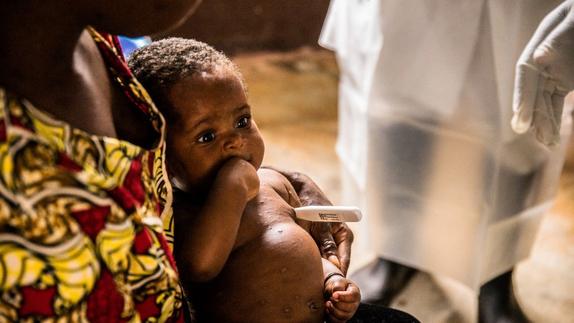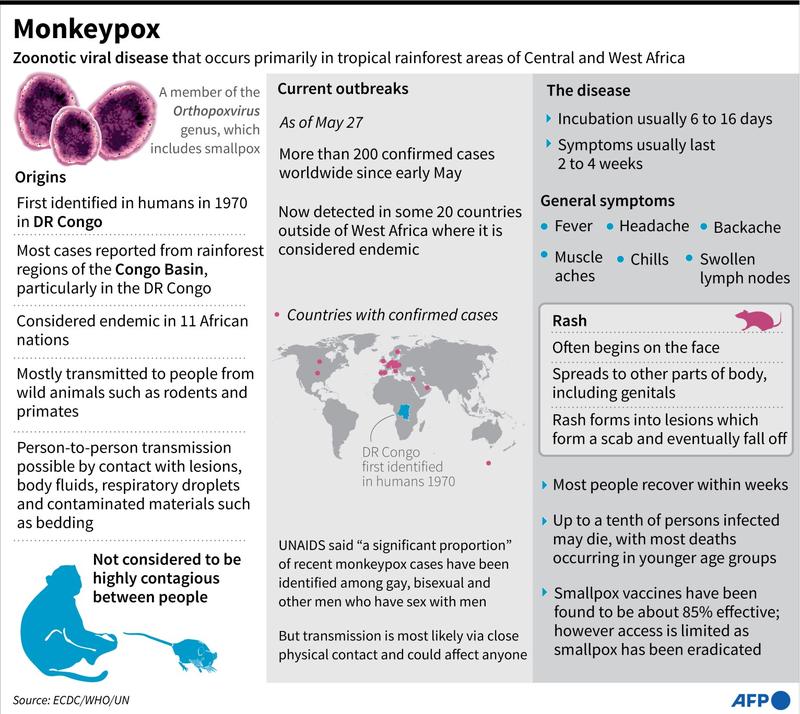 In this file photo taken on Oct 18, 2018, a woman and her child, both infected with monkeypox await treatment at the quarantine of the center of the International medical NGO Doctors Without Borders in the Lobaya region of the Central African Republic. (CHARLES BOUESSEL / AFP)
In this file photo taken on Oct 18, 2018, a woman and her child, both infected with monkeypox await treatment at the quarantine of the center of the International medical NGO Doctors Without Borders in the Lobaya region of the Central African Republic. (CHARLES BOUESSEL / AFP)
BERLIN/ BRAZZAVILLE - It is not clear yet whether the spread of monkeypox can be contained completely, the World Health Organization said on Tuesday, adding that its goal was to contain the outbreak by stopping human-to-human transmission to the maximum extent possible.
"Tools to manage it – including readily available diagnostics, vaccines and therapeutics – are not likely to be immediately or widely accessible to countries," it said in a statement.
Over 20 countries where monkeypox is not endemic have reported outbreaks of the viral disease, with more than 300 confirmed or suspected infections mostly in Europe.
Spain on Tuesday confirmed 12 new monkeypox cases, raising the tally to 132. At least 96 cases were from the Madrid region, while six are from Canary Islands and nine from Catalonia.
We must avoid having two different responses to monkeypox – one for Western countries which are only now experiencing significant transmission and another for Africa
Matshidiso Moeti, WHO regional director for Africa
Nearly 1,400 cases in Africa 2022
The WHO said on Tuesday that seven African countries have cumulatively reported nearly 1,400 monkeypox cases so far this year, with 1,392 suspected and 44 confirmed cases.
The cases have been reported from Cameroon, Central African Republic, the Democratic Republic of the Congo, Liberia, Nigeria, the Republic of the Congo, and Sierra Leone, said the WHO regional office for Africa, noting that the number of cases in 2022 is slightly fewer than half of the cases reported in 2021.
Until 2019, monkeypox in Nigeria was reported mainly in the south of the country but since 2020, the virus has moved into central, eastern, and northern parts of the country.
READ MORE: Unlikely monkeypox outbreak will lead to pandemic, WHO says
"We must avoid having two different responses to monkeypox - one for Western countries which are only now experiencing significant transmission and another for Africa," said Matshidiso Moeti, WHO regional director for Africa.
"We must work together and have joined-up global actions which include Africa's experience, expertise, and needs," said Moeti.

Monkeypox was first detected in humans in 1970 in the African region and since then most cases have been reported in rural and rainforest areas. For decades, only a few cases were reported sporadically.
In 2017, there was a sudden spike, with more than 2,800 suspected cases reported in five countries. This surge continued, peaking in 2020 with more than 6,300 suspected cases.
ALSO READ: Countries urged to take measures as monkeypox cases rise in EU
"Africa has successfully contained past monkeypox outbreaks and from what we know about the virus and modes of transmission, the rise in cases can be stopped," said Moeti.
Since the global eradication of smallpox in 1979, monkeypox has emerged as the most prevalent orthopoxvirus infection in humans. Vaccination against smallpox has been shown to be protective against monkeypox. A new vaccine against smallpox and monkeypox has been approved but is not yet widely available.
Monkeypox is common in wild animals like primates and rodents, but humans can also get infected. Symptoms include skin rashes, fever, headache, muscle ache, backache, swollen lymph nodes, chills, and exhaustion. The rash eventually forms a scab, which later falls off, indicating that the person is no longer infectious.


